
Eddy turns… without the turning bit!
Modern boat design has changed a lot about the way kayakers can paddle rivers these days. Rocker, hull design, boat length and volume distribution has made it possible to paddle harder rapids and waterfalls more safely. But let’s not forget about the basics: the simple technique of paddling in and out of eddies has changed in a few places, but stayed remarkably the same as well.
Speed… in the right direction!
Short boats and flat hulls make boats go slower and turn easier. Back in the day we had to anticipate and set up for eddies much earlier, but nowadays we can just turn the boat anywhere we want. And this makes it much easier to forget about the principles: speed and angle. Have you ever experienced that you were close enough to the eddy to touch it but still floated past it? It is essential to be as efficient as possible and make use of lateral momentum.
Imagine a bunch of medieval brawlers trying to get through the door of a local drinking facility. 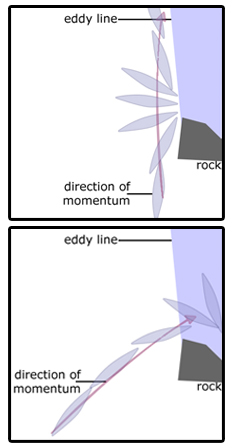
If the door is already half open, they will just walk in leisurely without effort. This is the case with very weak flow and slack eddy lines: you don’t need a lot of speed to get safely in the door. But if there is a bolt on the door and a cabinet behind it, the brawlers will need a storm ram and a lot of speed to get through, similarly to the paddler that needs a lot of speed to punch to a strong eddy line.
But here is the crux: our medieval louts would never even think of approaching that door side ways or at the wrong angle. They can’t run up alongside the pub wall and then quickly make a turn to face the door because they would just skid past it. You have to have speed, but you’re your speed has to be started, maintained and finished at a certain angle! This is why we cannot approach a right hand eddy by paddling up close to the right hand side and then making a sweep stroke to assume the proper angle just before you get there: if you want to go to the right, you have to come from the left…
So demonstrated in the first example, the boat has speed alongside the rock. At the start of the eddy, the boat is turned with a sweep stroke, but because all the speed was directed downstream, the boat will just turn and keep going… backwards.
In the second picture the boat comes from the left, makes speed (for the physics people amongst us: the x component of the vector is much larger) in the proper angle, and glides into the eddy without problems.
So if you want to go left, come from the right; if you want to go right, come from the left!
Appropriate strokes!
All strokes grow through the years. The aul Colorado Hook and the High Telemark Turn have since long been upgraded with more biomechanically and ergonomically sound principles, and with all the new boat developments, some strokes might find less use, or use in different places. In regards to the eddy turn, I would like to propose to place the low brace turn into the bin and use the bow rudder only to finish a turn.
So we’ve already established that modern boats spin and lose speed easier. Let’s also think about the reason and goal for paddling and resting into eddies. It’s not just to look cool, demonstrate your skills or pick flowers from the riverbank: it’s to get to safety, to gather the group, to break things down, to stop. Then lets now look at the geography of most eddies: you have the bank, the feature forming the eddy, the eddy line and the closer to the forming feature you are, the stronger the eddy line.
Where to aim
So where is the safest flattest place in the eddy, speaking in general? I found that it is the little spot right high up in the eddy, close to the bank, marked with a red dot. So depending on your plan of action once you get to the eddy, you would generally try to make it into the eddy as high up and as deep into the eddy as you can.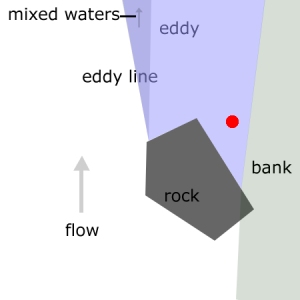
Considering the slow boat speed due to the modern designs, you would aim to keep your momentum as high as possible to be able to glide all the way into the eddy to get to the red dot. So in order to do that you want to keep your eye on 2 things
- Keeping the drag as low as possible
- Starting off with the right speed
The last point is the easiest, just look at the last paragraph and get that lateral momentum going. Keeping the drag low has a lot to do with keeping the boat pointing into the right direction, i.e. not skidding sideways.
Keeping a gradual arc
As soon as the nose of your boat makes contact with the still water in the eddy, it will start to spin out. In order to counteract that spinning, make a normal forward stroke in on the inside of the turn. The simplest solution! This will turn the angular speed (spinning) into forward speed again and drive you straight home.
So what have we been thought? Syllabi have told us for the last 40 years to make a sweep stroke on the outside of the turn. This will send the modern short boats spinning out and turning right inside the eddy line, right on the wobbly zone that will generally have some sort of downstream motion. So why did the syllabus tell us that? Because the longer boats wouldn’t turn so quickly and had much more speed, we used to need a little extra hand to make the ship turn. But not any more, so start stroking on the inside!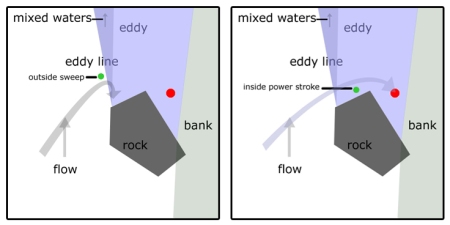
So have a look at the picture: in the first picture the radius of the turn is smaller, the arc is more curved, the boat turns quicker; whatever you want to call it. In the second picture the arc is more gradual and the boat planes into the eddy with less turn and more speed.
The pull from below
This has another advantage: if the boat planes into the eddy straight on as opposed from skidding sideways in, there is going to be less pressure onto the side of the boat: you have to edge less and you won’t get the river yanking on your boat on entry. It is much easier to gradually edge your boat and you will be less wobbly.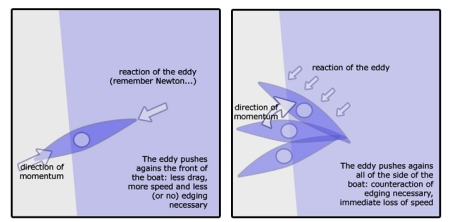
Bow rudders and low braces???
So back to the point: why lose the low brace turn? In all fairness, it does stop you from being wobbly, but if we don’t get wobbly in the first place by keeping the boat straight we don’t really need it. Low braces slow you down and make you spin out even more. You’re left right on that slow flowing eddy line…
The same goes for a bow rudder: you are forcing the turn to start even earlier and really whip your boat around on the danger zone. Great if that’s where you want to turn, i.e. if you want to leave pretty soon after, if the eddy is really small or if there is someone else in your favourite spot. But generally I like to go to the safe zone and use the inside stroke. Using this power saving efficiency stroke doesn’t mean I have to forget about the bow rudder: I can always finish the power stroke with a bow rudder by slicing it from the hip to the bow and end my gradual arc with a little twirl. But that is a different subject.
So in short: for paddling efficiently and smoothly into eddies we have to think about our lateral momentum, allowing us time to build up speed in the direction we want to drive the boat in. Then we need to time a stroke on the inside of the turn (depending on where we want to end up) as we come into the eddy (more on the timing of the stroke in later articles) to maintain a gradual open arc. Practise it. It’s worth it especially when you’re thinking about moving up to class IV…
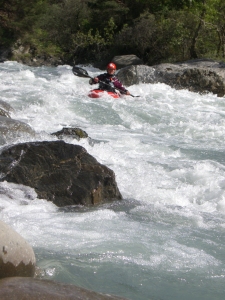
Hey Kim
Deadly article! I liked the bit about the red dot…it mad complete sense but I never heard anyone ever put it like that before!
…also it just so happens that on the level 3 instr course we’re doing this weekend, I have to demonstrate breaking in and out so I may rob a one or two of your pearls of wisdom if you don’t mind!
Thanks again for the other day, I know I was a little late (apologies!) but I got loads out of the day….in particular I think I’m gonna buy an All Star instead of tring to double pump my S8!
Anywho, talk to ya again
Rory
Hi Kim,
Cracking article! Very clear, and the best description I’ve seen of “new school” break outs…
One question though. On edging.
Above you say that, due to the entry angle, edging is hardly necessary. However, looking at experienced paddlers, and from the videos I’ve seen, in particular Simon Westgarth’s new Genotype 2 DVD (which you are in I believe?), there’s **A LOT** of edging going on in these break outs.
How important is this edging, and do you deliberatly put in such an extreme edge or does it come from the body rotation?
Cheers
Steve